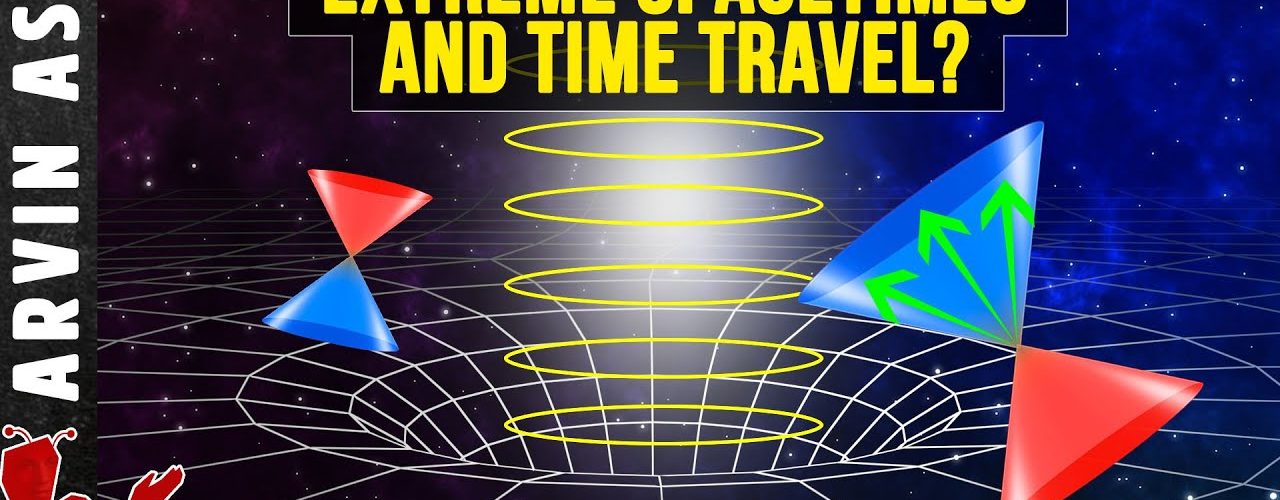Chapters
0:00 – You are a time traveler
2:32 – Spacetime & light cone review
6:15 – Flat Spacetime equations
7:03 – Schwarzschild radius, metric
8:42 – Light cone near a black hole
10:15 – How to escape black hole
10:39 – Kerr-Newman metric
11:34 – How to remove the event horizon
11:50 – What is a naked singularity
12:20 – How to travel back in time
13:26 – Problems
Summary
Time travel is nothing special. You’re time traveling right now into the future. Relativity theory shows higher gravity and higher speed can slow time down enough to allow you to potentially travel far into the future. But can you travel back in time to the past?
In this video I first do a quick review of light cones, world lines, events, light like curves, time-like curves, and space-like curves in this video so that you can understand the rest of the video.
A space like-world line means that the object has to travel faster than light. But moving anything to the speed of light requires an infinite amount of energy to accelerate. So this is not possible.
Going faster than the speed of light can create scenarios that allow you to travel back in time. But since this is not physically possible, we need to figure out a clever manipulation of space time. This means we have to solve Einstein’s equations of General relativity.
The simplest spacetime is a flat spacetime. The equation for this can be expressed in Cartesian or spherical coordinates. But to travel back in time we need more complex spacetime. The first solution ever presented to Einstein’s field equations was done by Karl Schwarzschild. He formulated non-flat spacetime that happened to describe a black hole, when no one had ever heard of it.
The r_s term in this equation is called the Schwarzschild radius. It is the point beyond which nothing can escape the black hole, because in order to escape, you would have to go faster than the speed of light, which you cannot do. In this equation when r is equal to r_s in the dr squared term, we get a zero in the denominator. This makes the term is undefinable. Its physical meaning is the event horizon.
Looking at the light cone of objects falling into the black hole, if the object is far away, then its cone is upright. As it starts falling into the black hole, it starts to tilt more and more as it falls further towards the black hole. Exactly at the event horizon, the light cone lies tilted at 45 degrees. All future events point to inside of the event horizon, meaning there is no escape from the black hole even at the speed of light, once you enter the event horizon.
Eventually the light cone will point completely towards the singularity at the center. This means that all future events will lie at the singularity. The singularity is a future moment in time rather than a point in space.
The spacetime inside black holes can allow travel back in time. But even if we can go back in time inside the black hole, the event horizon prevents us from escaping the black hole. So what good is it going back in time if we are trapped inside the black hole? It turns out there is a way to escape it.
In 1965 the Kerr-Newman metric was described by Ezra Newman. It describes a rotating black hole. There are ways we can remove the event horizon in this metric. When you do the math, we find that if the black hole is spinning fast enough, the event horizon disappears. It is then no longer a black hole, but a naked singularity. A naked singularity, is just a singularity with no event horizon.
This is important is because when you don’t have an event horizon, you can go near the singularity in the center, but come right back out. There is no event horizon, that otherwise prevents you from coming out of a black hole.
#timetravel
#nakedsingularity
Now we can theoretically travel back in time by going around the singularity. This happens because we can traverse a closed time like curve, which allows world lines from the future cone to loop around into the past light cone. We can loop our light cone around the singularity such that our future light cone ends up in the past light cone of where you started. And now since we are not bound inside the black hole by the boundary of the event horizon, we can come out of this spacetime back to about where we started, but at a time BEFORE we started. We went back in time.
But there are a few problems. First, theory doesn’t mean reality. Black holes may not be able to physically rotate fast enough for the event horizon to disappear. The math works with a test particle with little gravitation, but not at higher gravity such as that of a human.







